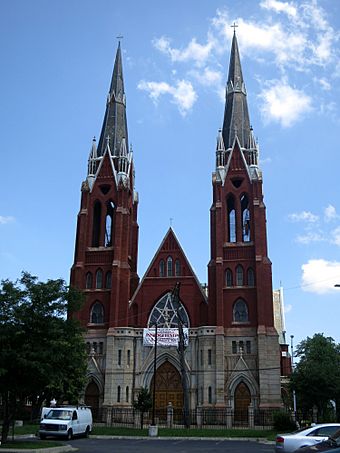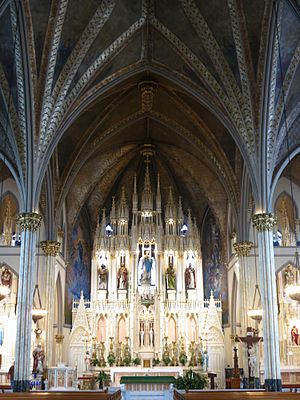Sweetest Heart of Mary Roman Catholic Church facts for kids
|
Sweetest Heart of Mary Roman Catholic Church
|
|
 |
|
| Location | 4440 Russell Street Detroit, Michigan |
|---|---|
| Built | 1893 |
| Architect | Spier & Rohns |
| Architectural style | Gothic Revival, Polish Cathedral |
| NRHP reference No. | 78001523 |
Quick facts for kids Significant dates |
|
| Added to NRHP | January 31, 1978 |
The Sweetest Heart of Mary Roman Catholic Church is a beautiful and historic church in Detroit, Michigan. You can find it at 4440 Russell Street, in the Forest Park neighborhood. This church is very important to the history of Detroit.
It was recognized as a Michigan State Historic Site in 1974. Later, in 1978, it was added to the National Register of Historic Places. For many years, this church, along with St. Albertus Roman Catholic Church and St. Josaphat Roman Catholic Church, served the large Polish community in Detroit. In 2013, Sweetest Heart of Mary and St. Josaphat joined together to form the Mother of Divine Mercy Parish.
History of the Church
Polish Immigrants in Detroit
In the 1800s, many Polish families moved to Detroit. They were looking for new opportunities. At first, these Polish immigrants attended St. Joseph's parish. This was a German-speaking church.
However, the Polish families wanted their own church. They wanted to worship in their own language. So, in 1871, about 300 Polish families started St. Albertus Parish. They built a simple wooden church.
Father Kolasinski and a New Parish
In 1882, a very energetic priest named Father Dominic Hippolytus Kolasinski became the pastor of St. Albertus. He helped the parish build a much larger church. This new St. Albertus Church was finished in 1885.
Later that year, Father Kolasinski was moved to a different church. But he returned to Detroit in 1888. He then started a new church called the Parish of the Sweetest Heart of Mary. This new church was not officially part of the Detroit Diocese at first. Soon after, a school building was added behind the church. This old school building is still there today.
Joining the Catholic Church
Father Kolasinski worked to bring his large group of followers back into the official Catholic Church. There were almost 4,000 families in his parish! The economic downturn of 1893, known as the Panic of 1893, made things difficult. Parish members had to get a loan to keep the church building.
Finally, the leaders in Rome told the Bishop of Detroit to make peace with Father Kolasinski. On February 18, 1894, the Sweetest Heart of Mary congregation officially became part of the Diocese of Detroit.
New Leaders and Growth
Father Kolasinski passed away in 1898. Other priests continued his work. Father Joseph Folta became pastor in 1899. He built a second school and a permanent rectory (the priest's house). He also added a decorative fence around the church.
Father Folta was followed by Father Joseph Casimir Plagens in 1919. Father Plagens later became a Bishop. He added beautiful decorations inside the church. He also built a permanent convent for the Sisters of St. Joseph. These sisters taught at the parish school.
Changes Over Time
During Father Plagens's time, the church was very busy. The school had almost 1,500 students! The church was a central place for both spiritual and social life in the community.
However, as people moved to different areas, the number of church members slowly decreased. This trend continued for many years.
Restoration and Revival
In 1976, Father Bohdan Kosicki became the new priest. He started a big project to restore the church building. He also worked to bring back former members. He raised money for the restoration work.
Because of these efforts, Sweetest Heart of Mary was listed on the National Register of Historic Places in 1978. It also received state and city historic designations. The beautiful stained glass windows and the organ were repaired. Much of the main altar was also renovated. The old school building was made stable, and the convent and fence were restored.
Father Kosicki's work was continued by Father Alphons Gorecki. More work was done to fix the interior, repair plasterwork, and update the electrical system.
From 2002 to 2010, Father Mark A. Borkowski was the pastor. He continued the restoration and helped the church grow. During this time, the Annual Pierogi Festival became very popular. It grew into the largest religious festival in Detroit.
Architecture of the Church
Building Design and Construction
Construction on the church began in 1890. It was designed by the architects Spier and Rohns. This church was planned to be the largest Catholic Church in Michigan. Father Kolasinski helped raise the money for the building.
The first stone was laid on June 5, 1892. The church was officially dedicated on December 24, 1893. It cost over $125,000 to build. More than 10,000 people came to the dedication ceremony!
Gothic Revival Style
Sweetest Heart of Mary is one of the largest and most impressive Gothic Revival churches in the Midwest. This style often features tall, pointed arches and detailed stonework.
The church is made of red brick and shaped like a cross. It has a cross-shaped roof. The front of the church has a stone lower level with three main entrances. Above these entrances are pointed arches and a stone railing. Two tall towers stand on each side of the entrance. They have pointed spires on top, decorated with crosses.
Stained Glass Windows and Organ
The church has several amazing stained glass windows. They were made by Detroit Stained Glass Works. One large window shows the Holy Family in Saint Joseph's workshop. Eight windows along the main aisle show Christ, Mary, and several saints. These windows even won a major prize at the 1893 World's Columbian Exposition in Chicago.
There are also three other important buildings connected to the church. These include a large rectory, a convent for many religious sisters, and a big school building. Together, they form a local historic area.
The church also has a very old pipe organ. It was built in 1893 by Austin Organs, Inc. This organ is the oldest Austin Organ still being used today. It is also the oldest surviving electro-pneumatic organ in Michigan.
See also
 In Spanish: Iglesia del Corazón Dulcísimo de María para niños
In Spanish: Iglesia del Corazón Dulcísimo de María para niños
- Archdiocese of Detroit
- Architecture of metropolitan Detroit



